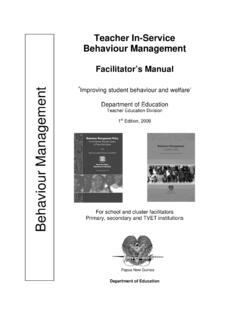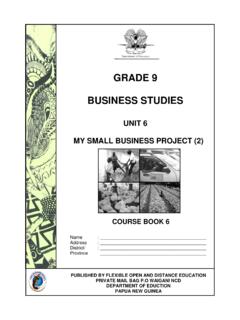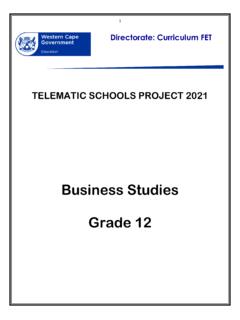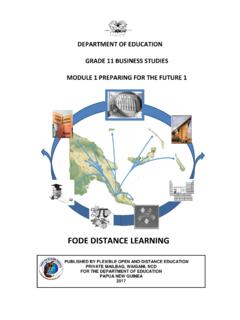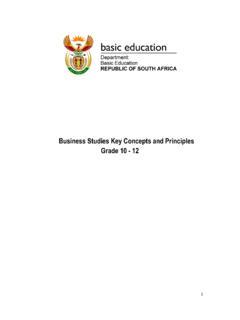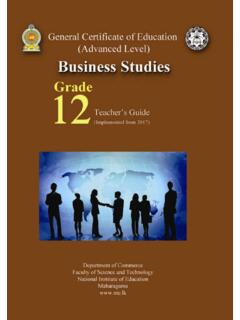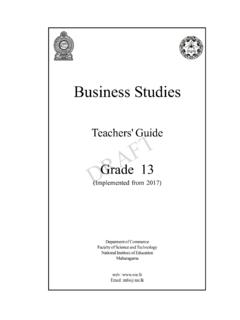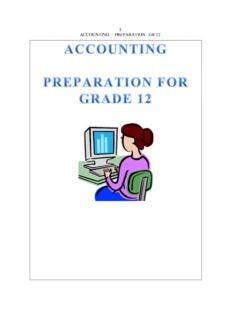Transcription of GRADE 10 BUSINESS STUDIES - education.gov.pg
1 GRADE 10 BUSINESS STUDIES UNIT 2 KEEPING ACCOUNTS IN A SMALL BUSINESS COURSE BOOK 2 FLEXIBLE, OPEN AND DISTANCE EDUCATION PRIVATE MAIL BAG, WAIGANI, NCD PAPUA NEW GUINEA Name: _____ Address: _____ District/: _____ Province _____ GR10 BS U2 3 WRITERS & EDITORS Writer: Doris Payok Editor: Silas Umaropi Sub-editors: Alison Chalapan Gilbert Ikupu Tiden Irima Lucy Joseph Max Paro Diana Waikali Ursual Yallon GR10 BS U2 1 WRITERS & EDITORS GRADE 10 BUSINESS STUDIES UNIT 2 KEEPING ACCOUNTS IN A SMALL BUSINESS In this unit you will learn.
2 TOPIC 1: BOOKKEEPING IN A SMALL BUSINESS TOPIC 2: TAKING STOCK TOPIC 3: CALCULATING PROFIT CASH AND CREDIT TRANSACTIONS TOPIC 4: THE USE OF A CHEQUE ACCOUNT GR10 BS U2 2 ACKNOWLEDGEMENTS & ISBN Written by: Doris Payok Published in 2017 by the Flexible, Open and Distance Education Copyright 2017, Department of Education, Papua New Guinea All rights reserved. No part of this publication may be reproduced, stored in a retrieval system, or transmitted in any form or by any means electronic, mechanical, photocopying, recording or otherwise without prior permission of the publisher. Printed by the Flexible, Open and Distance Education ISBN: 978-9980-89356-7 National Library Services of Papua New Guinea Acknowledgements We acknowledge the contributions of all Primary Teachers who in one way or another helped to develop this course.
3 Our profound gratitude goes to the former Principal, Mr Demas Tongogo for leading FODE team towards this great achievement. Special thanks to the staff of MAL and BUSINESS STUDIES Department of FODE who played an active role in coordinating writing workshops, outsourcing lesson writing and editing processes. We also acknowledge the professional guidance provided by Curriculum and Development Assessment Division throughout the processes of writing and, the services given by member of the Primary Section and Academic Committees. The Course Book was developed with the support and funding of the GO- PNG FODE World Bank Project. DIANA TEIT AKIS PRINCIPAL GR 10 BS U2 3 CONTENTS TABLE OF CONTENTS Title 1 2 Table of content.
4 3 Secretary s message .. 5 Unit 6 Study Guide .. 7 Topic 1: Bookkeeping in a Small 9 Topic 10 Lesson 1: Introduction to keeping Accounts in Small 11 Lesson 2: Documents In Cash 19 Lesson 3: Recording Cash Transactions .. 29 Lesson 4: Using BUSINESS Incomes .. 39 Lesson 5: Documents in Credit 47 Lesson 6: Recording Credit Transactions .. 55 Answers to Practice Exercises1- 63 Topic 2: Taking 71 Topic 72 Lesson 7: Stock Taking and Stock Take 73 Lesson 8: Stock Keeping 79 Lesson 9: Stock taking and Stock 87 Answers to Practice Exercises 7-9 93 Topic 3: Calculating Profit-Cash and Credit Transaction .. 97 Topic 98 Lesson 10: Profit and Source 93 Lesson 11: Calculating Profit in Cash and Credit 99 Lesson 12: Profit and Loss Statement.
5 105 Lesson 13: The Balance Sheet .. 123 Lesson 14: The Profit and Loss Statement .. 129 Answers to Practice Exercises 10-14 .. 137 Topic 4: The Use of Cheque Account .. 145 Topic 146 Lesson 15: The Cheque 147 Lesson 16: Cash Book and Cheque 157 GR 10 BS U2 4 CONTENTS Lesson 17: The Bank Reconciliation 165 Answers to Practice Exercises 175 Answers to Unit Lesson 181 201 GR10 BS U2 5 SECRETARY S MESSAGE SECRETARY S MESSAGE Achieving a better future by individual students and their families, communities or the nation as a whole, depends on the kind of curriculum and the way it is delivered. This course is part and parcel of the new reformed curriculum.
6 The learning outcomes are student centred and allow them to be demonstrated, assessed or measured. It maintains the rationale, goals, aims and principles of the national curriculum and identifies the knowledge, skills, attitudes and values that students should achieve. This is a provision by Flexible, Open and Distance Education as an alternative pathway of formal education. The course promotes Papua New Guinea values and beliefs which are found in our Constitution, Government policies and reports. It is developed in line with the National Education Plan (2005 -2014) and addresses an increase in the number of school leavers which has been coupled with a lack of access to secondary and higher educational institutions. Flexible, Open and Distance Education curriculum is guided by the Department of Education s Mission which is fivefold: To facilitate and promote the integral development of every individual To develop and encourage an education system which satisfies the requirements of Papua New Guinea and its people To establish, preserve and improve standards of education throughout Papua New Guinea To make the benefits of such education available as widely as possible to all of the people To make the education accessible to the poor and physically, mentally and socially handicapped as well as to those who are educationally disadvantaged.
7 The college is enhanced to provide alternative and comparable pathways for students and adults to complete their education through a one system, many pathways and same outcomes. It is our vision that Papua New Guineans harness all appropriate and affordable technologies to pursue this program. I commend all those teachers, curriculum writers and instructional designers who have contributed so much in developing this course. GR 9 BS U1 6 INTRODUCTION UNIT 2: KEEPING ACCOUNTS IN A SMALL BUSINESS The Unit 2 Course Book has four (4) Topics. These Topics are; Topic 1: Bookkeeping in a Small BUSINESS This Topic will explain the importance of bookkeeping and how to calculate profit for a small BUSINESS . Topic 2: Taking Stock This Topic teaches you about taking stock for a small BUSINESS , how to record this stock using the methods of stock taking and to also calculate the value of stock.
8 Topic 3: Calculating Profit- Cash and Credit Transactions This Topic will teach you how to calculate profit using source documents involving cash and credit transactions. Topic 4: The use of cheque account This Topic will explain to you how to use a cheque account. It will teach you how to prepare financial reports like the Profit and Loss Statement and Bank Reconciliation Statement by using cheque account and Cash Book. Dear Student, Welcome to GRADE 10 BUSINESS STUDIES Unit 2 Keeping Accounts in a Small BUSINESS . This Unit will teach you to keep accurate records of any BUSINESS activity and also to apply book keeping skills in a range of small BUSINESS situation. You will learn how to use the source documents to calculate profit and prepare financial reports like Balance Sheets and Bank Reconciliation Statement.
9 GR 10 BS U1 7 STUDY GUIDE STUDY GUIDE Step 1: Start with Topic 1, study Lesson 1 and do the Lesson Activities as you go along. When you have completed Lesson 1, do Practice Exercise 1. Step 2: When you have completed Lesson 1 Activities and Practice Exercise 1, turn to the end of Topic 1 in the Unit Book to correct your answers. The answers for your Practice Exercises are at the end of the Topic while the answers for your Lesson Activities are at the end of the Unit Book. Step 3: If you make any mistake, go back to the Lesson and revise well and try to understand why you gave an incorrect answer. Step 4: When you have completed steps 1-3, tick the box for Lesson 1 on the Contents page (page 3) like this, Topic 1: Bookkeeping in a Small BUSINESS Lesson 1: Introduction to Keeping Accounts in my Small BUSINESS Step 5: Go to Lesson 2 and repeat the same process until you complete all the Lessons in Topic 1 Step 6: After completing your Lessons and Practice Exercises in Topic 1, then complete each Topic Test in Assessment Book 2.
10 Step 7: After you have studied the whole Unit, do also the Unit Examination in the Assessment Book 2. Step 8: Check through your Assessment Book 2 when you are satisfied then forward it to your provincial center for marking. The provincial center will advise you on how to apply for your external examinations. Icons Introduction Target of the Lesson Lesson Activity and Practice Exercise Summary Assessment You will do four (4) Topic Tests and a Unit Examination. Your assessment book will be marked by your distance teacher. The marks you score will count towards your final mark and GRADE . If your score is less than 50% in any assignment, you must repeat that assignment. If you continue to score less than 50% in your assignment three consecutive times, then, your enrolment will be cancelled, and you need to re-enroll if you wish to continue this Course.



